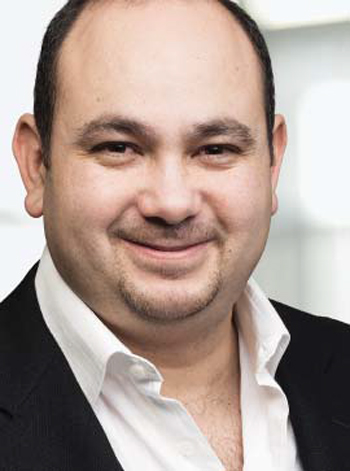Two McGill researchers – Prof. Ehab Abouheif, of the Department of Biology, and Prof. Aashish Clerk, Department of Physics – have been named as 2014 recipients of E.W.R Steacie Memorial Fellowships, awarded by the Natural Sciences and Engineering Research Council of Canada (NSERC). In addition, doctoral candidate Michael Lifshitz, working in the cognitive neuroscience lab of Prof. Amir Raz, has won NSERC’s 2013 André Hamer Postgraduate Prize. All three prizes will be presented to the researchers at a special ceremony today at the Governor General of Canada’s residence, Rideau Hall, in Ottawa.
“McGill is extremely proud of Dr. Abouheif’s and Dr. Clerk’s creativity and leadership in research and education in the biological sciences, and the physics of engineered quantum systems, which NSERC has acknowledged with these prestigious fellowships,” said Rose Goldstein, Vice-Principal (Research and International Relations). “I also extend my congratulations to the winner of the André Hamer Postgraduate Prize, the up-and-coming innovator Michael Lifshitz.”

About Ehab Abouheif’s work
Biologist Ehab Abouheif’s breakthrough discoveries are facilitated by fusing the fields of ecology, evolution and developmental biology (called “eco-evo-devo”) to uncover the rules that underlie the interactions between an organism’s genes and its environment. Abouheif has revealed that dormant ancestral genes exist in all animals, and that it is possible to revive these genes with the right triggers. He is applying his research to understand environmental factors that can trigger a genetic trait that causes cancer.
The following is NSERC’s profile on Abouheif:
Canadian research that turned certain kinds of ants into “supersoldiers” with huge oblong heads and giant vicious jaws could have important implications for breeding crops with higher nutritional value or tackling the mechanisms that cause cancer.
McGill biologist Dr. Ehab Abouheif’s breakthrough discovery came by fusing the fields of ecology, evolution and developmental biology (called “eco-evo-devo”) to uncover the rules that underlie the interactions between an organism’s genes and its environment.
His research revealed that dormant ancestral genes exist in all animals, and that it is possible to revive these genes with the right triggers. His test case was a particular ant genus — Pheidole —that shares a common genetic trait, producing three distinct kinds of workers: minor workers, soldiers and supersoldiers. Though supersoldiers were lost in this genus about 35 to 65 million years ago, Dr. Abouheif’s group showed it was possible to unlock this hidden genetic potential by applying high doses of hormone at a critical stage in the larvae’s development.
Dr. Abouheif, recipient of a 2014 Steacie Memorial Fellowship, believes this powerful evolutionary force could be used to unlock dormant genes in plants to make them healthier and to understand changes in the environment that trigger a genetic trait that causes cancer.
Only 11 years since finishing his PhD, Dr. Abouheif has already firmly established himself as an international leader in this emerging field.

About Aashish Clerk’s work
Quantum mechanics has radically changed the way we view the physical world, leading to revolutionary technologies including transistors, lasers and magnetic resonance imaging. Aashish Clerk has developed new theories demonstrating how to harness the quantum interaction between photons and mechanical motion in engineered systems. He is widely considered to be one of the world’s most prominent young theorists focusing on the physics of engineered quantum systems.
The following is NSERC’s profile on Clerk:
Arguably the most successful scientific theory of the 20th century, quantum mechanics has radically changed the way we view the physical world, leading to revolutionary technologies including transistors, lasers and magnetic resonance imaging.
The next evolution in quantum-driven technology promises to be just as transformative, led by rising scientific stars such as Dr. Aashish Clerk, a Yale University graduate now working at McGill University. The Canada Research Chair and 2014 recipient of a Steacie Memorial Fellowship is widely considered one of the world’s most prominent young theorists focusing on the physics of engineered quantum systems.
A big advantage is that quantum devices, like circuits on a chip, can be designed from the bottom up, allowing for an almost infinite range of possibilities. The potential applications of engineered quantum systems are vast and include fundamentally new methods for computing and information processing, as well as the development of powerful new sensors for detecting chemicals and pathogens.
Among other accomplishments, Dr. Clerk has developed new theory showing how to harness the quantum interaction between light particles (photons) and mechanical motion in engineered systems. These ideas have been implemented in many state-of-the-art experiments, published in leading journals like Science and Nature. He has also shown how to make sensitive measurements of energy levels in semiconductor “artificial atoms” (also known as quantum dots) — an important step in using these systems for next-generation technologies such as solar energy systems.

About Michael Lifshitz’s work
Michael Lifshitz, a doctoral candidate in neuroscience, and winner of a Vanier Canada Scholarship, is working with Amir Raz, Canada Research Chair in the Cognitive Neuroscience of Attention, to prove how mental training can improve behaviour. His research uses non-invasive brain imaging to show how mental training strengthens brain networks, resulting in improved cognitive, emotional and social aptitude.
The following is NSERC’s profile on Lifshitz:
A group of Montreal first graders are on the frontlines of an innovative study that is blending clinical psychology and cognitive neuroscience to develop a drug-free way to improve attention skills.
One of the research team’s new recruits is Michael Lifshitz, a doctoral candidate in neuroscience and winner of both a Vanier Canada Scholarship and doctoral level NSERC 2013 André Hamer Postgraduate Prize. His long list of accomplishments includes five first-author research papers and several local, provincial, national and international awards.
He is currently working with Dr. Amir Raz, a Canada Research Chair in the Cognitive Neuroscience of Attention, to prove how age-appropriate mental training — in this case, a four-week program — can improve a child’s behaviour both at school and at home. The study uses non-invasive brain imaging to show how such training strengthens brain networks, resulting in improved cognitive, emotional and social aptitudes.
The research is contributing to our fundamental understanding of brain development, while providing practical knowledge that can be used to improve education.

